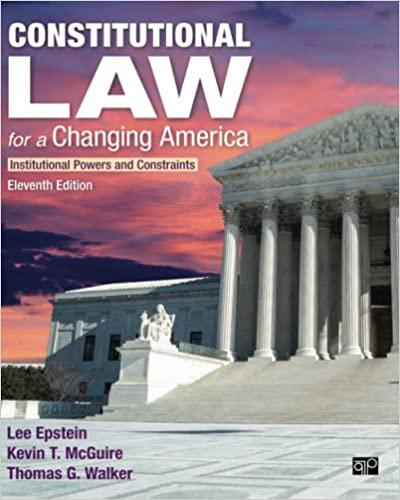Question
1- According to the textbook, there are three types of torts intentional torts, negligent torts and strict liability torts .To successfully sue a defendant for
1- According to the textbook, there are three types of tortsintentional torts, negligent tortsandstrict liability torts.To successfully sue a defendant for an intentional tort (assault, defamation etc.) the plaintiff must prove that the "defendant possessed the intent to do the act that caused the plaintiff's injury" (Cheeseman, page 95.) Under strict liability, "a participant in a covered activity is liable for any injuries caused by that activity, even if he or she is not negligent."(Cheeseman, page 111).
Briefly explain the five (5) things the plaintiff must prove to be successful in a negligence tort case. ( A list without additional explanation will receive only a small portion of the available points).
2- A defendant in a tort lawsuit may claim he/she is not liable for the plaintiff's injuries because the plaintiff's own negligence caused his/her own injuries.Explain how each of the following standards is applied to the defendant's liability in a tort case.
a.Contributory negligence
b. Pure comparative negligence
c. Partial comparative negligence
3- Briefly explain what a person who is hurt by a product must prove against the defendant under thenegligencedoctrine of product liability. Is everyone in the chain of distribution liable to the plaintiff under this theory? Why is it difficult for a plaintiff to prove a negligence product liability case?(Note:This question refers specifically to a negligence product liability suit.This is not exactly the same as the response for Question 1.)
4- Briefly explain what the plaintiff must prove if he/she is injured by a product and he/she choses to sue under themisrepresentationdoctrine?Is the person or business who misrepresented the product liable to everyone who is injured by the product?If not who is he/she liable to?
5- The doctrine ofstrict liabilityremoves many of the difficulties for the plaintiff associated with negligence and misrepresentation. For strict liability, product liability answer the following questions:
1.Is the plaintiff required to prove anyone was negligent?
2.Is the manufacturer of the product the only one that may be liable to an injured plaintiff?Explain.
3.The plaintiff must prove that the products was defective.Explain three ways (discussed in your textbook) that a product may be defective.
4.Many sellers will avoid liability for a defective product by selling the product "as is."This is called a disclaimer.Canstrict liabilitybe disclaimed?
Step by Step Solution
There are 3 Steps involved in it
Step: 1

Get Instant Access to Expert-Tailored Solutions
See step-by-step solutions with expert insights and AI powered tools for academic success
Step: 2

Step: 3

Ace Your Homework with AI
Get the answers you need in no time with our AI-driven, step-by-step assistance
Get Started


